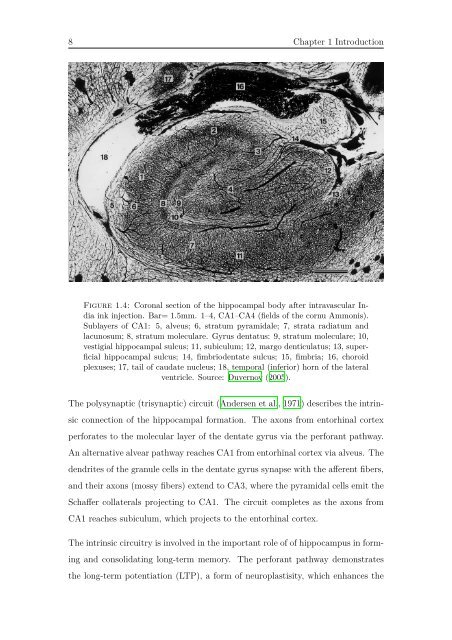Docteur de l'université Automatic Segmentation and Shape Analysis ...
Docteur de l'université Automatic Segmentation and Shape Analysis ...
Docteur de l'université Automatic Segmentation and Shape Analysis ...
Create successful ePaper yourself
Turn your PDF publications into a flip-book with our unique Google optimized e-Paper software.
8 Chapter 1 Introduction<br />
Figure 1.4: Coronal section of the hippocampal body after intravascular India<br />
ink injection. Bar= 1.5mm. 1–4, CA1–CA4 (fields of the cornu Ammonis).<br />
Sublayers of CA1: 5, alveus; 6, stratum pyramidale; 7, strata radiatum <strong>and</strong><br />
lacunosum; 8, stratum moleculare. Gyrus <strong>de</strong>ntatus: 9, stratum moleculare; 10,<br />
vestigial hippocampal sulcus; 11, subiculum; 12, margo <strong>de</strong>nticulatus; 13, superficial<br />
hippocampal sulcus; 14, fimbrio<strong>de</strong>ntate sulcus; 15, fimbria; 16, choroid<br />
plexuses; 17, tail of caudate nucleus; 18, temporal (inferior) horn of the lateral<br />
ventricle. Source: Duvernoy (2005).<br />
The polysynaptic (trisynaptic) circuit (An<strong>de</strong>rsen et al., 1971) <strong>de</strong>scribes the intrin-<br />
sic connection of the hippocampal formation. The axons from entorhinal cortex<br />
perforates to the molecular layer of the <strong>de</strong>ntate gyrus via the perforant pathway.<br />
An alternative alvear pathway reaches CA1 from entorhinal cortex via alveus. The<br />
<strong>de</strong>ndrites of the granule cells in the <strong>de</strong>ntate gyrus synapse with the afferent fibers,<br />
<strong>and</strong> their axons (mossy fibers) extend to CA3, where the pyramidal cells emit the<br />
Schaffer collaterals projecting to CA1. The circuit completes as the axons from<br />
CA1 reaches subiculum, which projects to the entorhinal cortex.<br />
The intrinsic circuitry is involved in the important role of of hippocampus in form-<br />
ing <strong>and</strong> consolidating long-term memory. The perforant pathway <strong>de</strong>monstrates<br />
the long-term potentiation (LTP), a form of neuroplastisity, which enhances the
















